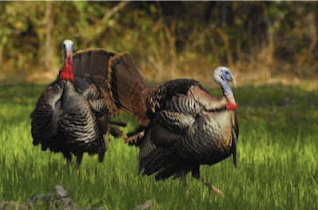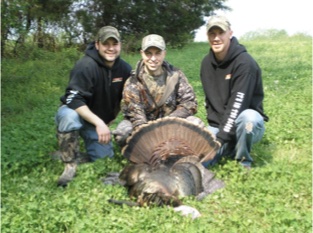Turkeys: The Spring Food Plot Equation

By Sam Parrish
Meteorologists must not turkey hunt. Well, maybe some of them do, but not most. If they did, they’d surely lobby their respective state game agencies to ensure that spring turkey season opened when the weather was warm and comfortable. If you’ve turkey hunted much, you know that’s not always the case.
I experienced that firsthand last spring, when Wisconsin’s second turkey
period coincided with howling winds and sub-freezing temperatures.
Although I didn’t enjoy dressing like I was on a late-season duck hunt, I was
fairly optimistic. Sure, the birds would still be wadded up in large winter groups. Yes, they probably wouldn’t gobble much. And of course, I wouldn’t be able to sit for more than an hour or two without being miserable. However, a friend’s foresight had given me an ace in the hole: an early-season food source.
EATING WHAT’S ON THEIR PLATE
Many folks underestimate the importance of food for turkey hunting because turkeys aren’t very picky at the buffet. Just ask Lovett E. Williams Jr., one of North America’s best-known turkey biologists. “Turkeys are among the most resourceful feeders, consuming hundreds of different kinds of insects, other small animals and plant parts, including almost everything that is edible and some things that are not,” Williams wrote in Wild Turkey Hunting and Management. At various times of year, turkeys prefer seeds, insects, grasses, leaves, waste grain, and hard and soft mast. Throughout much of spring, summer and fall, they have abundant food. However, as any wildlife farmer knows, natural chow can be scarce in late winter and early spring, so turkeys will seek out the best food sources in their home range. Often, the best options are logging roads, wildlife openings and food plots with the year’s first green shoots of vegetation. Turkeys use openings throughout the year, but when those openings represent the best food option early in spring, they can congregate there en masse. “Grasses and clovers are good plants to use in your wildlife openings and are especially important to wild turkeys,” according to the National Wild Turkey Federation. “They offer excellent foraging and brood habitat for adult wild turkeys and turkey poults. These plants can produce a large amount of seed, which benefit mature birds, and attract hordes of insects, the essential element of a young turkey's diet. Additionally, grasses and clovers help control erosion when planted on roads, logging decks and fallow fields. “With little maintenance, grasses and clovers planted together will provide several years’ worth of high-quality habitat for wild turkeys and other wildlife.” That’s what my friend had figured the previous year, when he planted several food plots specifically for turkeys. The plots double as great white-tail habitat, of course, but he locates them in areas where early-season birds will use them heavily.
“Well-managed feeding cover should be located near favored seasonal roosts,” Williams wrote. “Aldo Leopold called this juxtaposition — an exercise in geometry.”
CAMPING OUT AT THE FOOD
The food plot I’d chosen to hunt opening day was tucked neatly beneath a massive hardwood ridge and was bordered on the other side by a creek. Several large winter flocks had roosted in the tall oaks and maples much of the winter, and based on the tracks and scratching in the food plot, they’d found a favorite early-spring food source. And with winter-like weather entrenched over Wisconsin, I figured an easy early-season food source would attract hens — and that a gobbler or two might follow. I didn’t hear any roost gobbling that morning, but I’d counted on that. Actually, that made my decision to camp out at the food plot even easier. It made little sense to move and try to locate a turkey in the open April woods if they weren’t talking. An hour passed with no action, and I started to long for the warmer days of late spring turkey hunting. Just as I was about to shift my weight and get some blood back in my toes, a blue head popped up from the creek bottom on the other side of the plot. Several more followed. “Hens,” I thought. “No longbeard, though. I wonder where he’s at.” An ear-splitting gobble from farther up the creek bottom provided my answer. He was following the hens to the field. I dared not move with the hen flock so close. The birds pecked at the green shoots in the clover plot and slowly filtered past me onto the open hardwood ridge. After they had disappeared from sight, however, the gobbler still hadn’t showed, so I clucked and purred lightly on my slate. Sure enough, drumming filled the air, and I looked up to see the bird slowly walking and strutting into the food plot, following the path the hens had taken. I slowly shifted my gun to the left and counted down the distance until he was at 40 steps. Then, I squeezed the trigger and dropped the gobbler in his tracks.
CONCLUSION

As I picked up the long-spurred gobbler, I thought about the simplicity of the hunt. Sure, it hadn’t been a classic morning full of gobbling action, but the quiet wait had been well worth it. When conditions aren’t ideal, turkey hunters must adapt, and food plots give a great early-season fallback plan.
In fact, I may plant my own Imperial Whitetail clover plot this spring!
